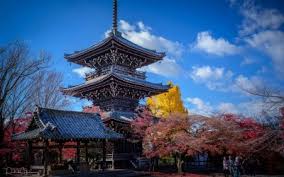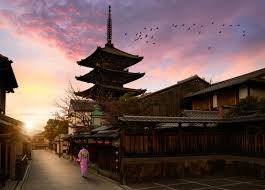Kyoto, Japan’s ancient capital, is renowned for its rich cultural heritage, which is vividly reflected in its stunning array of temples. With a history that spans over a millennium, Kyoto boasts some of the most breathtaking and historically significant temples in Japan. For travelers and history enthusiasts alike, exploring Kyoto’s ancient temples offers a unique glimpse into Japan’s spiritual and architectural legacy. In this guide, we’ll take you on a journey through Kyoto’s most iconic temples, exploring their history, architectural marvels, and cultural significance.
1. Introduction to Kyoto’s Temples

Historical Context
Kyoto served as Japan’s capital from 794 to 1868, during which it became the epicenter of Japanese culture, politics, and religion. The city’s long history is encapsulated in its numerous temples, which were constructed to honor deities, commemorate historical figures, and provide spiritual solace. Kyoto’s temples are not just religious sites but also masterpieces of Japanese architecture and art, each telling its own story through its design and historical significance.
Cultural Significance
The temples of Kyoto are integral to Japan’s cultural heritage and are recognized as UNESCO World Heritage Sites. They reflect various aspects of Japanese culture, including Zen Buddhism, Shinto beliefs, and traditional Japanese aesthetics. Visiting these temples provides insight into the spiritual and artistic achievements of ancient Japan, making them essential destinations for anyone interested in Japanese culture and history.
2. Must-Visit Temples in Kyoto
Kinkaku-ji (The Golden Pavilion)
Overview
Kinkaku-ji, officially known as Rokuon-ji, is one of Kyoto’s most iconic temples, famous for its stunning gold-leaf-covered exterior. Located in the northern part of the city, this Zen Buddhist temple is set amidst beautifully landscaped gardens and a reflective pond, enhancing its picturesque beauty.
History and Architecture
Originally built in 1397 as a retirement villa for shogun Ashikaga Yoshimitsu, Kinkaku-ji was converted into a Zen temple after his death. The temple’s top two floors are covered in gold leaf, making it shine brilliantly in the sunlight. The architecture is an excellent example of the Shōin style, characterized by its elegant simplicity and harmony with nature.
Visitor Experience
Visitors can stroll around the temple’s tranquil gardens and enjoy views of the golden pavilion reflected in the pond. The temple’s serene atmosphere and stunning visuals make it a must-see for anyone visiting Kyoto.
Kiyomizu-dera
Overview
Kiyomizu-dera, which translates to “Pure Water Temple,” is one of Kyoto’s oldest and most revered temples. Perched on a hillside in eastern Kyoto, it offers panoramic views of the city and the surrounding landscapes.
History and Architecture
Established in 778, Kiyomizu-dera is renowned for its wooden stage that juts out over a hillside, supported by hundreds of wooden pillars. The temple’s main hall, Hondo, is dedicated to Kannon, the Buddhist goddess of mercy. The temple’s name derives from the Otowa Waterfall that runs beneath it, whose waters are believed to have healing properties.
Visitor Experience
Visitors can explore the temple’s numerous halls, walk along the picturesque paths lined with cherry and maple trees, and drink from the sacred Otowa Waterfall. Kiyomizu-dera’s stunning architecture and beautiful views make it a highlight of any Kyoto visit.
Fushimi Inari Taisha
Overview
Fushimi Inari Taisha is renowned for its thousands of vermilion torii gates that create a mesmerizing pathway up Mount Inari. Located in southern Kyoto, this Shinto shrine is dedicated to Inari, the deity of rice and agriculture.
History and Architecture
Founded in 711, Fushimi Inari Taisha is known for its distinctive torii gates, which were donated by individuals and businesses seeking Inari’s blessings. The gates create a tunnel-like effect as visitors walk through them, leading up to the shrine’s main sanctuary.
Visitor Experience
Walking through the torii gate pathway is a surreal experience, especially in the early morning or late afternoon when the light creates magical effects. The shrine also offers numerous trails for those who wish to explore further up the mountain.
Ginkaku-ji (The Silver Pavilion)
Overview
Ginkaku-ji, or the Silver Pavilion, is known for its understated elegance and tranquil surroundings. Located at the base of Kyoto’s eastern hills, the temple provides a serene escape from the city’s hustle and bustle.
History and Architecture
Constructed in 1482 as a retirement villa for shogun Ashikaga Yoshimasa, Ginkaku-ji was later converted into a Zen temple. Unlike its name suggests, the temple is not covered in silver but is instead celebrated for its simple yet refined beauty, which reflects the aesthetics of the Higashiyama period.
Visitor Experience
The temple’s beautifully manicured gardens, including a moss garden and a sand garden known as the Karesansui, offer a peaceful environment for contemplation. The temple’s architecture and natural setting provide a glimpse into the refined tastes of the period.
Ryoan-ji
Overview
Ryoan-ji is famous for its Zen rock garden, which is considered a masterpiece of Japanese landscape design. Located in northern Kyoto, this temple is an essential destination for those interested in Zen Buddhism and Japanese garden aesthetics.
History and Architecture
Founded in 1450, Ryoan-ji is renowned for its minimalist rock garden, which features 15 rocks arranged in a way that only 14 are visible at any one time. The garden’s design is meant to evoke a sense of meditation and contemplation.
Visitor Experience
Visitors can sit quietly by the rock garden and reflect on its intricate design, which invites various interpretations. The temple’s peaceful surroundings and architectural simplicity offer a contemplative retreat.
3. Tips for Visiting Kyoto’s Temples

Respect Local Customs
When visiting temples, it’s important to follow local customs and etiquette. Dress modestly, remove your shoes before entering temple buildings, and maintain a respectful demeanor. Many temples have specific rules about photography, so be sure to observe any posted signs.
Best Time to Visit
Kyoto’s temples are beautiful year-round, but spring and autumn offer particularly stunning scenery. Spring brings cherry blossoms, while autumn features vibrant foliage. Early mornings and late afternoons are ideal times to visit to avoid crowds and enjoy a more tranquil experience.
Getting Around
Kyoto’s temples are spread across the city, so it’s helpful to plan your visit in advance. Public transportation, such as buses and trains, is efficient, and many temples are within walking distance of each other. Consider purchasing a Kyoto City Bus & Kyoto Bus One-Day Pass for convenience.
4. Conclusion
Discovering the ancient temples of Kyoto is a journey through Japan’s rich cultural and spiritual heritage. Each temple offers a unique glimpse into the country’s history, architecture, and religious practices, making them essential destinations for any traveler. From the glittering Kinkaku-ji to the serene Ryoan-ji, Kyoto’s temples provide an unforgettable experience that blends the beauty of the past with the tranquility of the present. As you explore these timeless landmarks, you’ll gain a deeper appreciation for Kyoto’s profound legacy and its enduring charm.



